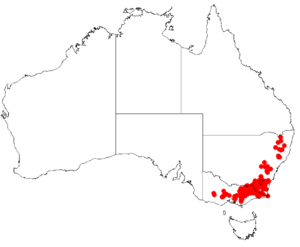Dwarf geebung facts for kids
Quick facts for kids Dwarf geebung |
|
|---|---|
 |
|
| Persoonia chamaepeuce in the Alpine National Park | |
| Scientific classification | |
| Genus: |
Persoonia
|
| Species: |
chamaepeuce
|
 |
|
| Occurrence data downloaded from AVH | |
| Synonyms | |
|
Linkia chamaepeuce (Lhotsky ex Meisn.) Kuntze |
|
The Persoonia chamaepeuce, also called the dwarf geebung or heathy geebung, is a cool plant from the Proteaceae family. It only grows in south-eastern Australia. It's a low-growing bush with lots of thin leaves and pretty yellow flowers that grow where the leaves meet the stem.
Contents
What Does the Dwarf Geebung Look Like?
The dwarf geebung is a shrub that grows flat on the ground. Sometimes, its branches might lift up to about 30 cm (12 in) tall. Its young branches are smooth.
Leaves and Flowers
This plant has smooth, thin leaves. They are usually 8 to 25 mm (0.3 to 1 in) long and 1 to 2 mm (0.04 to 0.08 in) wide. They can be straight or a bit curved, with a slightly hollow top surface.
The yellow flowers grow one by one where the leaves join the stem. Each flower sits on a smooth stalk, about 3 to 6 mm (0.1 to 0.2 in) long. The flower has four hairy parts called tepals, which are 9 to 13 mm (0.4 to 0.5 in) long. These tepals are joined at the bottom, but their tips curl back.
Inside the flower, there's a central part called a style. Four yellow anthers surround it. These anthers are also joined at the bottom with curled-back tips. If you look at the flower from the end, it looks like a cross! Each anther has a tiny spine, about 1 mm (0.04 in) long, on its end.
Fruit and Flowering Time
Dwarf geebungs flower from December to March. After flowering, they produce yellowish-green, oval-shaped fruits. These fruits are called drupes and are about 10 mm (0.4 in) long and 6 mm (0.2 in) wide.
Sometimes, people confuse the dwarf geebung with a similar plant, Persoonia chamaepitys. However, P. chamaepitys has more crowded, rounder leaves.
How Was the Dwarf Geebung Named?
The dwarf geebung, Persoonia chamaepeuce, got its official scientific name in 1856. A botanist named Carl Meissner described it using notes from another botanist, John Lhotsky.
Meaning of the Name
The name chamaepeuce comes from ancient Greek words. Chamai means "on the ground" or "dwarf," and peuke means "pine." So, its name basically means "dwarf pine," which makes sense because it's a low-growing plant.
Over time, other botanists tried to rename the plant or thought they found new species that turned out to be the dwarf geebung. For example, in 1919, a French botanist named Michel Gandoger described three new species that were later found to be P. chamaepeuce.
Plant Family and Hybrids
In 1995, a botanist named Peter Weston studied the Persoonia genus. He put P. chamaepeuce into a group called the Lanceolata group. This group has 54 species that look similar, especially their flowers, but their leaves can be very different.
These plants often interbreed, meaning they can create hybrids if different species grow near each other. Hybrids of the dwarf geebung have been found with other geebung species like Persoonia asperula, Persoonia confertiflora, and Persoonia linearis.
Where Does the Dwarf Geebung Grow?
The dwarf geebung grows in forests and woodlands. You can find it on the high lands, called tablelands, stretching south from the New England area in New South Wales all the way to Victoria. In Victoria, it's very common in mountain and subalpine areas, which are high-altitude regions.
Can You Grow Dwarf Geebung in Your Garden?
Yes, you can! The dwarf geebung is a good plant to use as a groundcover in gardens because it stays low and has pretty flowers. You can grow it from seeds, but it needs a sunny spot with soil that drains water well. Even though it grows slowly, it adapts well to being grown in gardens in places with a mild climate.

